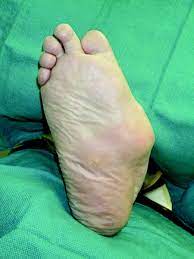
Charcot foot, also known as Charcot arthropathy, is a condition in which the bones and joints in the foot break down due to nerve damage. This can cause the foot to become deformed, and can also lead to instability, fractures, and joint dislocations.
Charcot foot is most commonly seen in people with diabetes who have peripheral neuropathy, which is nerve damage that can cause loss of sensation in the feet. Without proper sensation, people with peripheral neuropathy may continue to walk or bear weight on an injured foot, leading to further damage.
Symptoms of Charcot foot include swelling, warmth, and redness in the foot or ankle, as well as deformities such as a collapsed arch, a rocker-bottom foot shape, or an abnormally shaped foot. If left untreated, Charcot foot can lead to severe deformities that may require surgery or amputation.
Treatment for Charcot foot typically involves immobilising the foot and avoiding weight-bearing activities until the bones and joints can heal. In some cases, surgery may be necessary to repair fractures or correct deformities. It is important for people with diabetes to take steps to manage their blood sugar levels and prevent peripheral neuropathy, as well as to monitor their feet regularly for signs of injury or infection.
